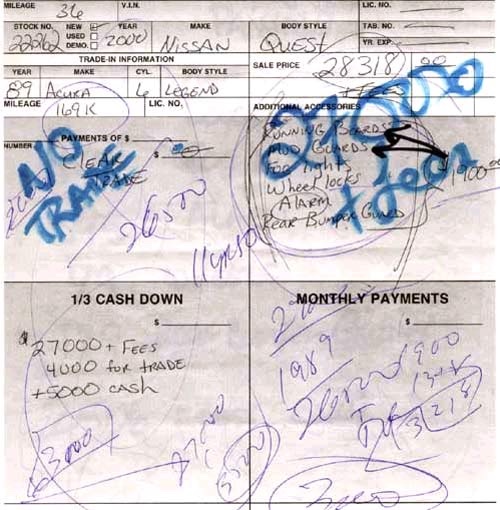The “Four Square” Technique Gives the Retail Car Industry a Bad Name
By Ted Ings, Executive Director
The retail market place is changing, and sales managers need to change with it.
Customers have become savvier and are wising up to many of the classic “old school” negotiating techniques commonly used by car dealers.
One of the worst offenders is the “Four Square” sales method and it has to go.
This is a technique that has been around for decades and has been used effectively by dealers to confuse customers and get them to buy into a deal that, at best is to their disadvantage, and at worst, simply rips them off. It discredits salespeople and gives the retail car industry a bad name.
The Four Square sales technique and how it works
The “Four Square” sales method is an adversarial process that is introduced when the customer has selected a car and is ready to sit down with the salesperson and negotiate the price. The technique is designed to “shock” and confuse the customer into closing a deal that only benefits the dealership. It is the salesperson’s opportunity to work the numbers and is a sleazy negotiating technique that should be avoided at all costs if you want to run a reputable business and build a trustworthy brand.
When applying the Four Square sales method, the salesperson literally draws four squares on a piece of paper. Dealerships that regularly use the 4 Square technique usually have pre-printed sheets of paper with the four squares already marked out. The squares are marked with the following information;
Price of vehicle
This is the purchase price of the new vehicle. Often the dealer will initially only write down the base price in this block, and then added the additional costs like sales tax and licensing fees later, to make the deal look more attractive at first glance.
Trade-in value
This is the price the dealership is prepared to pay for the customer’s existing vehicle.
Down payment
In this quadrant, the salesperson puts down the cash amount that the customer is prepared to pay upfront. Generally, a dealership will ask a customer to put down one-third of the purchase price of the new vehicle, but this does vary from dealer to dealer.
Monthly payments
This is usually the last of the four blocks and here the salesperson puts down the monthly payment that the customer is willing or able to pay – it is usually the smallest figure on the page, but it is very significant. The salesperson will try to get the buyer to focus on this number because it looks small and manageable compared to the thousands that they will be paying overall. It is a safe number and most inexperienced car buyers fall for this trick. They focus on the monthly payments because that is what is important to them and will have the greatest impact on their monthly budget. And this is exactly where the salesperson wants the customer to focus because that is the easiest number for the buyer to process but it is also the easiest number for the salesperson to manipulate.
It is important to note that all four quadrants are related to one another and therefore any changes that are made in one block can be adjusted and recouped in one of the other blocks.
By constantly moving the numbers around and mixing them together, the salesperson can easily confuse the customer and make it look like they are getting a good deal even when this is just not the case.
For example, if the buyer negotiates a better trade-in price for their existing vehicle, the salesperson will simply increase the monthly payments to offset this cost, and at the end of the day, the salesperson will ensure that they make the same amount of money on the deal.
The trick is to make the customer believe that they have negotiated a good deal when actually they have gained nothing. In fact, in the worst-case scenario, the Four Square technique is being used to rip off the buyer.
Need Training? Book a Complimentary "Ask the Expert" Discovery Call with Ted Ings
Exclusively for Dealers, Executive Managers and OEM/Lenders/Suppliers
The salesperson knows that if they can get the buyer to focus on one square and believe that they have negotiated a good deal in that quadrant, they won’t notice that they are being ripped off in the other three squares.
WHO NEEDS TRAINING AT YOUR DEALERSHIP?
During the entire Four Square negotiation process, the salesperson is writing down numbers, scratching numbers out, writing new numbers, circling other numbers, drawing arrows and symbols, and generally scribbling on the piece of paper until it is a confusing jumble of numbers and notes and scratches. At the end of the process, the customer is totally bamboozled by what can best be described as salesperson sleight-of-hand.
Customers can protect themselves from the Four Square sales technique
The good news for customers is that they don’t have to be victims of the Four Square sales technique.
One of the easiest ways to take control of the sales process is to keep the deal as simple as possible and not link all the components of the sale. For example, a customer could sell their existing car out of hand or arrange their financing through a third party. By simply removing one of the elements from the deal, the customer has greater control of the negotiating process and can avoid doing the Four Square dance.
But for the dealership, losing one element of the deal is not ideal and therefore salespeople need to clean up their act and negotiate honestly with customers so that the sales process has a pleasant outcome for everyone. This is an essential part of building long term relationships and cultivating return business.
It is not always possible for a customer to remove one of the elements from the deal, but this does not mean that they have to negotiate all four aspects simultaneously.
WHO IS TED INGS?
By compartmentalize the different transactions, and dealing with each one separately, customers can still remain in control. When you buy a car, it is important to do your homework, know your numbers and remain committed to your budget. This will ensure that you are not bamboozled by the Four Square method.
If you think it is confusing just reading about the Four Square technique, imagine what it is like being subjected to it by an experienced salesperson who has closed countless deals using this method.
The best way to rid the car sales industry of this unscrupulous practice is for customers to boycott dealerships that still insist on using the 4 Square method and purchase vehicles from reputable dealers who are focused on building long term relationships rather than making quick sales.





